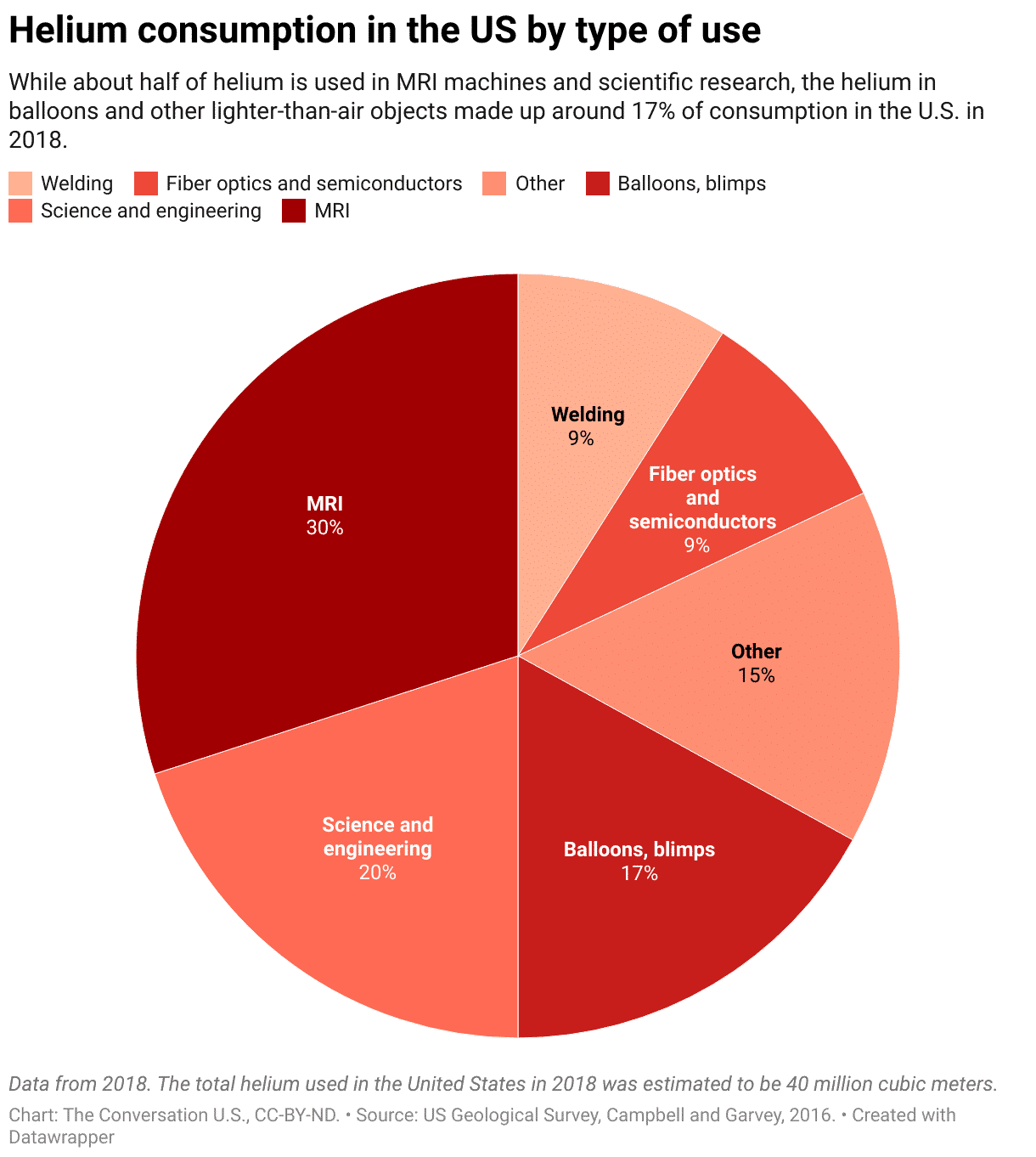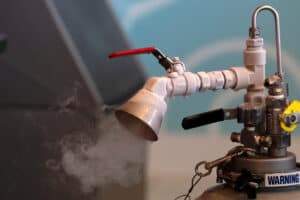Helium is an essential material for research and medical equipment, but it’s nonrenewable and difficult to recycle

The next time you pick up balloons for your big party, remember the helium gas in those balloons is destined for the stars. Helium is so light that it easily escapes Earth’s gravity, and all helium will eventually make its way into space. Like fossil fuels, helium is a limited resource.
Helium shortages have become an acute problem for many researchers. Since early 2022, a variety of factors have put pressure on the global helium market, including the potential sale of the U.S.’s publicly held helium reserves and production infrastructure, sanctions against Russia and a series of breakdowns at helium plants.
Four helium shortages have occurred over the past decade, and these disruptions affect several high-tech industries. Beyond inflating balloons, helium plays a part in welding for certain metals and in making semiconductors.
Medical imaging and chemical analysis research also use helium. Liquid helium cooled to minus-450 degrees Fahrenheit (minus-268 degrees Celsius) keeps the superconducting magnets in instruments like magnetic resonance imaging, or MRI, and nuclear magnetic resonance, or NMR, systems cool.

Helium shortages put pressure on many industries, and when a shortage hits, helium costs can spike dramatically. Even consumers can be affected – prices for inflated party balloons and helium tank kits have increased substantially.
Helium in research – a cold conundrum
Both MRI and NMR instruments require extremely strong magnetic fields to operate. The most efficient way to generate those fields uses superconducting wire. A superconducting electrical current generates a magnetic field, and once started, these currents can continue for decades without additional electrical input.
But there is a catch. Without liquid helium, the wires quickly warm up. Over time, the helium used to cool the magnets evaporates. The superconductivity goes away, and the magnetic field dissipates.
Earlier this year, LK-99, a potential new room-temperature superconductor made headlines worldwide. Such a material, if found, could eliminate the need for helium in MRI and NMR systems.
So far, LK-99 has not produced a breakthrough in superconductivity, although scientists are still hunting for new superconducting materials.
Until scientists find a functional room temperature superconductor, MRI and NMR facilities need helium. A small to midsize university or hospital may spend US$20,000 per year on liquid helium, as every few months, their liquid helium supplies need replenishing.
Larger facilities need more, and over the past two to three years, the price of helium has doubled. Some institutions have been forced to de-energize their instruments as a result. This process shuts down the magnetic field, effectively halting the instrument’s activity until the facility can buy helium again.
New helium on the horizon
One approach to address the helium shortage involves seeking additional helium sources. Helium is normally obtained as a byproduct of drilling for natural gas, since helium collects underground in pockets containing methane and other hydrocarbons.
Methane is a greenhouse gas, and burning natural gas releases carbon dioxide into the atmosphere. Methane and carbon dioxide in the atmosphere contribute to climate change.
But pockets of helium that aren’t mixed with natural gas could exist in places underground. Researchers searching in Africa have identified what could be a major store of helium in Tanzania’s Rukwa Region.
At least two companies are actively trying to locate these pockets, which originate from unique volcanic activity in the area. Drilling at these sites could be a more climate-friendly alternative – although any form of drilling has local environmental impacts.
As of early December 2023, the helium levels found from drilling these pockets seem promising. The most recent exploration reveals helium levels of at least 2% to 3%, more than 1,000 times normal atmospheric levels. This is on par with other drilling sites that produce helium.

Two companies are currently searching for helium in Africa, and both plan to continue searching for higher helium levels. However, independent industry assessments estimate that new helium facilities may not come online until 2025 or later.
Even so, these efforts do not solve the bigger problem – the need for a renewable helium source.
Reusing existing helium
Until scientists have reliable, room-temperature superconductors or find an unlimited helium supply, conserving available helium is the best route forward. Fortunately, this is becoming easier to do.
Researchers at Iowa State University began recycling their helium in the 1960s. Since then, this technology has become cheaper, and both the U.S. National Science Foundation and the U.S. National Institutes of Health have funded efforts to install helium recovery equipment in academic research settings.
These systems are becoming more common, even in smaller NMR facilities. And scientists, including researchers in my lab, are helping each other by sharing their experiences installing this equipment.
Helium recovery systems involve three main components. First, there is a system that transports evaporated helium from the superconducting magnets. This component monitors the evaporation rate and ensures a steady flow through the system.

Second, there is a collection system. For large facilities, this consists of a large, flexible bag. The bag expands as it collects the evaporated helium, storing it temporarily. This bag is the size of a small car, and where space is a concern, smaller facilities can use helium tanks for storage.
Third, there is a system that reliquefies the gaseous helium. This is the most expensive component, and it uses electrical energy to cool the helium. Once liquefied, the facility staff transfers the helium back to the magnets.
While the helium shortage has led to significant challenges, many scientists are optimistic about the future. Researchers continue to search for room-temperature superconductors. New helium facilities in Tanzania could increase supply. And more widespread access to helium recovery equipment is allowing scientists to conserve this valuable resource.
Nicholas Fitzkee, Professor of Chemistry, Mississippi State University
This article is republished from The Conversation under a Creative Commons license. Read the original article.
今度、盛大なパーティーのために風船を手に取るとき、風船の中のヘリウムガスが星に向かう運命にあることを思い出してほしい。ヘリウムは非常に軽いため、地球の重力から容易に逃れることができ、すべてのヘリウムは最終的に宇宙へと向かう。化石燃料と同様、ヘリウムも限りある資源だ。
ヘリウム不足は多くの研究者にとって深刻な問題となっている。2022年初頭以来、米国が公的に保有するヘリウム埋蔵量と生産インフラの売却の可能性、対ロシア制裁、ヘリウムプラントの相次ぐ故障など、さまざまな要因が世界のヘリウム市場に圧力をかけている。
過去10年間に4回のヘリウム不足が発生し、これらの混乱はいくつかのハイテク産業に影響を及ぼしている。風船を膨らませるだけでなく、ヘリウムは特定の金属の溶接や半導体の製造にも使われている。
医療用画像診断や化学分析研究にもヘリウムが使われている。華氏マイナス450度(摂氏マイナス268度)に冷却された液体ヘリウムは、磁気共鳴画像装置(MRI)や核磁気共鳴装置(NMR)のような装置の超伝導磁石を冷却する。

ヘリウム不足は多くの産業を圧迫し、不足に陥るとヘリウムコストは劇的に跳ね上がる。消費者でさえ影響を受ける可能性があり、膨らませたパーティー用風船やヘリウム・タンク・キットの価格は大幅に上昇している。
研究におけるヘリウム
MRI装置もNMR装置も、作動には極めて強い磁場を必要とする。磁場を発生させる最も効率的な方法は、超電導線材を使用することである。超電導電流は磁場を発生させ、一度電流が流れ始めると、追加の電気入力なしに何十年も電流を流し続けることができる。
しかし、ひとつ問題がある。液体ヘリウムがないと、線材はすぐに温まってしまうのだ。時間が経つにつれ、磁石の冷却に使われたヘリウムは蒸発してしまう。超伝導は消え、磁場は消滅する。
今年初め、LK-99という新しい室温超伝導体の可能性が世界中で話題になった。このような物質が見つかれば、MRIやNMRシステムでヘリウムが不要になる可能性がある。
これまでのところ、LK-99は超伝導のブレークスルーをもたらしていないが、科学者たちは今も新しい超伝導材料を探している。
科学者が機能的な室温超伝導体を見つけるまでは、MRIやNMR施設にはヘリウムが必要である。中小規模の大学や病院では、数ヶ月ごとに液体ヘリウムの補充が必要になるため、液体ヘリウムに年間20,000米ドルを費やすこともある。
大規模な施設ではさらに多くのヘリウムが必要となり、過去2~3年の間にヘリウムの価格は2倍に跳ね上がった。その結果、装置の通電を停止せざるを得なくなった施設もある。このプロセスは磁場をシャットダウンし、施設が再びヘリウムを購入できるようになるまで、装置の活動を事実上停止させる。

新たなヘリウムの可能性
ヘリウム不足に対処するひとつの方法は、ヘリウムの供給源を増やすことである。ヘリウムは通常、天然ガスを掘削する際に副産物として得られる。
メタンは温室効果ガスであり、天然ガスを燃焼させると二酸化炭素が大気中に放出される。大気中のメタンと二酸化炭素は気候変動の原因となる。
しかし、天然ガスと混合していないヘリウムのポケットが地下に存在する可能性がある。アフリカで探索中の研究者たちは、タンザニアのルクワ地方にヘリウムの一大貯蔵庫があることを突き止めた。

少なくとも2つの企業が、この地域のユニークな火山活動に由来するこれらのポケットを積極的に見つけようとしている。このような場所での掘削は、より気候変動に優しい代替手段となりうる。
2023年12月初旬の時点で、これらのポケットを掘削して発見されたヘリウムレベルは有望なようだ。最新の探査では、少なくとも2%から3%のヘリウムが検出されており、これは通常の大気レベルの1,000倍以上である。これは、ヘリウムを産出する他の掘削現場と同レベルである。
現在、2社がアフリカでヘリウムの探索を行っており、両社ともより高いヘリウムレベルの探索を継続する予定である。しかし、独立した業界の評価では、新たなヘリウム施設が稼動するのは2025年以降になる可能性があると推定されている。
それでも、こうした努力は、より大きな問題、つまり再生可能なヘリウム源の必要性を解決するものではない。
既存のヘリウムの再利用
科学者が信頼できる常温超伝導体を手に入れるか、無限のヘリウム供給源を見つけるまでは、利用可能なヘリウムを節約することが最善の道である。幸いなことに、これは容易にできるようになってきている。
アイオワ州立大学の研究者たちは、1960年代にヘリウムのリサイクルを始めた。それ以来、この技術は安価になり、米国国立科学財団と米国国立衛生研究所の両方が、学術研究環境にヘリウム回収装置を設置する取り組みに資金を提供している。
こうしたシステムは、小規模なNMR施設でも一般的になりつつある。そして、私の研究室の研究者を含む科学者たちは、この装置を設置した経験を共有することで、互いに助け合っている。
ヘリウム回収システムには3つの主要コンポーネントがある。まず、超伝導マグネットから蒸発したヘリウムを輸送するシステムがある。このコンポーネントは蒸発速度をモニターし、システム内の安定した流れを確保する。

第二に、回収システムがある。大規模な施設の場合、これは大きくて柔軟性のあるバッグで構成される。バッグは蒸発したヘリウムを集めると膨張し、一時的に貯蔵する。このバッグは小型車ほどの大きさで、スペースが気になる場合は、小規模の施設ではヘリウムタンクを貯蔵に使うことができる。

第三に、気体ヘリウムを再液化するシステムがある。これは最も高価なコンポーネントで、ヘリウムを冷却するために電気エネルギーを使用する。液化されると、施設のスタッフがヘリウムを磁石に戻す。
ヘリウム不足は大きな課題となっているが、多くの科学者は将来について楽観的である。研究者たちは常温超伝導体の探索を続けている。タンザニアの新しいヘリウム施設は、供給を増やす可能性がある。また、ヘリウム回収装置へのアクセスがより広まったことで、科学者たちはこの貴重な資源を節約できるようになっている。








コメントを残す